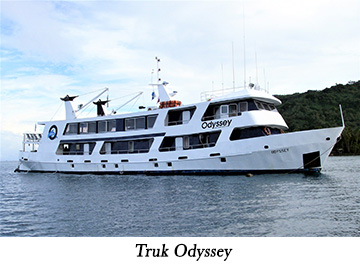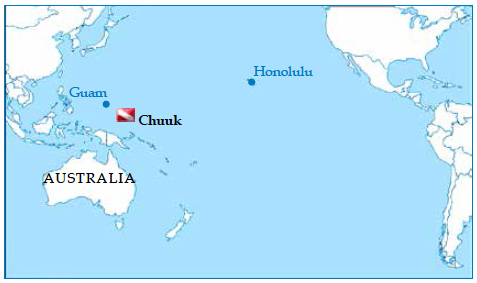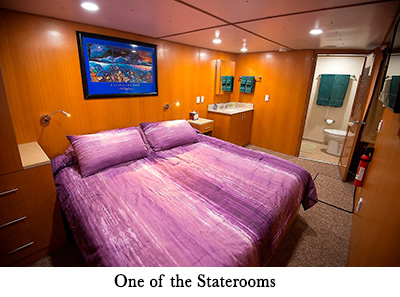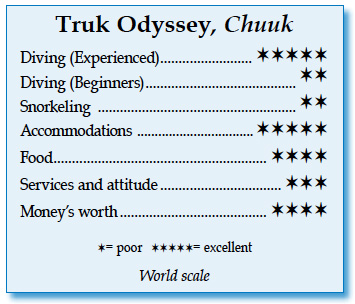Truk Odyssey, Chuuk, MicronesiaContents of this Issue: Truk Odyssey, Chuuk, Micronesia Thereís an Easier Way to Dump Air from Your BC By Land or by Sea: What Makes for the Best Diving? Cozumel, Raja Ampat, Cuba, Grand Turk . . . Reader Reports: Easier to Write, and Now with Photos Got any Tales of Unexpected Dive Travel Bills? Yes, Sport Divers Get PTSD, Too Even Royal Family Members Are Dive Fatalities Snorkeler Gets Swallowed by a Whale Fly for Free to Your Dive Destination Dragon Smugglers Forcing a Shutdown of Komodo Island The Real-Time Data Every Dive Computer Should Have How This Diverís Coastal Cleanup Plan Has Turned Him into a Hero Trinidad Diver Survives a 44-Mile Swim Editorial Office: Ben Davison Publisher and Editor Undercurrent 3020 Bridgeway, Suite 102 Sausalito, CA 94965 great rooms, food, and wreck dives, but an unattentive crew from the May, 2019 issue of Undercurrent
Dear Fellow Diver: The 132-foot Truk Odyssey arrives at the dock at Blue Lagoon Resort every Saturday at 5 p.m. sharp to pick up guests. My dive buddy and I were ready to be loaded onto a skiff with our luggage for a seven-day charter. The other two with us were a Canadian couple in their 50s who had dived the world but had never been to Chuuk (the island's official name, although Truk Lagoon is what the world-famous dive site is typically called). They weren't technical divers, but as I mentioned in last month's travel story (I wrote about my three-day stay at Blue Lagoon Resort so I could compare Truk's land-based and boat-based diving), many of the dives, featuring wrecks of Japan's WWII fleet, are within sport divers' depths. Still, would they have the skills to handle diving down deep into dark, cramped ship holds? And could they do that all easily with an 80-cu-ft aluminum tank, and without dive guides there to monitor them? As I found out, my fellow divers on this trip were a great example for showing the pros and cons of sport diving on wreck dives below 100 feet.
As an early boarder, I took first dibs on dive stations, and started setting up gear. The dive deck was a spacious one, with storage bins under the seats and room for two tanks in racks at each station. My buddy and I were doing side-mount diving (read John Bantin's story last month about why it's so great). With side-mounted tanks, the one on my left side is set up with a standard valve, while the right has a valve with the handle on the opposite side, so that the two valves are mirror images of each other. The Odyssey carries sets of double tanks, each with right- and left-hand valves connected together, that can be taken apart to make two tanks with the proper side-mount valve configuration. But on my trip, the not-so-great crew (more on them later) was reluctant to split them up. Fortunately, I brought my own nonstandard valve for the right tank, and the crew fulfilled my request by installing it on one of their 80-cubic-foot aluminum tanks. Nitrox was included for those certified, and it ran at 29 percent. The remaining 12 divers, a group from Louisiana, had arrived in the middle of the night, so I met them when breakfast started at 6:30 a.m. They were quiet and sluggish over coffee and toast (those are available all morning), but remembering the jet lag involved with my three flights and two overnights to Chuuk, I empathized. The boat moved to the first dive site while I ate fruit followed by pancakes off the menu, while my buddy opted for an omelet. Captain Mike always started his briefing with a little history of the ship from his documentary, The Wrecks of Truk Lagoon, then explained the best way to dive the wreck, along with what we would expect to see. Most of the divers had not been diving long, so Mike gave stern warnings about penetration and depths, and he recommended that they ask guides to come along. Although openwater certification is all that's required to dive Truk Lagoon, many wrecks sit at the deeper range of recreational limits. "That means you have to be extra diligent in watching your computers and pressure gauges," Mike said. Dar, a native New Yorker originally trained as a chef, has been the Odyssey's lead dive guide and instructor for two years and was thrilled to meet us. I guess because he was constantly surrounded by recreational divers, he was excited to finally have some people to "really" dive with, so he offered us an engine room tour of the Nippo Maru. At 153 feet deep, that's one of the deeper wrecks on the Odyssey itinerary, so I opted for trimix. I put on my full wetsuit (to avoid cuts from jagged rusty metal), two tanks of trimix, a pony bottle filled with a deco gas, a helmet to protect my head from overhead hazards, and dive lights. Finning through Nippo Maru's tight, dark and silty passageways, I followed Dar into a small room that housed a steam-driven engine. He led me past three field artillery guns on the deck and into the aft hold, filled with huge gun turrets and anti-aircraft guns. We worked our way to the next hold, which must have been the hospital -- I easily recognized wheelchairs, hospital beds and lab equipment like petri dishes and vials. On our way out, I passed through the pilot house, where the captain's wheel still hung solemnly on its stand. I enjoyed that 58-minute tour, and not having to worry about narcosis because I was on trimix made it even better. What made me nervous was that Dar dived with 24-percent Nitrox, which had a high potential for narcosis. I wished the Odyssey's owners let their guides dive with trimix free of charge on the deeper sites -- divemasters can do it if they choose, but they have to pay the fill charge of $1.75 a cubic foot out of their own pocket.
The other divers were comfortable in the 84-degree water, but most of them sure needed to work on their trim and buoyancy skills. Swimming in a feet-down position doesn't work well when penetrating silty engine rooms down at 100 feet. The guides I saw with other divers didn't do anything to help them -- after all, they were there to lead them through the ships, not teach skills. Odyssey Adventures doesn't have any dive rules, other than to dive within your limits. If you're trained in decompression procedures, they allow deco diving. But I could see these divers were nervous about deep dives, and most of them tended to stay on the shallow ends of the wrecks. They all had buddies or made buddy teams when other divers didn't want to dive, but the crew never mentioned having to stay together, and teams didn't have to go with a guide -- which could spell trouble. On our second day out, one Louisiana diver felt nauseous and fatigued, and sported a sore, purple blotchy belly. Another noticed a bruised-looking area under his ribs. The crew diagnosed them with skin bends, then put them both on oxygen and told them not to dive for 24 hours. When their symptoms subsided, the divers were allowed back in the water, but both had relapses and missed the rest of the week's diving. While they had paid attention to their computers and stayed within their no-deco limits, it goes to show how Truk Lagoon's deep diving has side effects.
On the upper level was a sun deck with loungers and a covered area with tables and chairs -- a relaxing hangout in the sunny, 85-degree afternoons -- and the galley and dining room, where Emeren, a quiet, reserved Chuukese woman, prepared superb buffet-style meals. I had seconds on hamburger and pizza nights, and her steak and lobster dinner got a standing ovation. Fresh produce was difficult to get on remote Chuuk, so Emeren often had to resort to canned vegetables and fruit, but she did her best to make them palatable. I couldn't wait till after the morning dive, when she served pumpkin bread or chocolate chip cookies hot from the oven. Between afternoon dives, savory snacks like sushi or chicken wings were up for grabs. Unfortunately, I can't rave about the rest of the dive crew, local Chuukese men of varying ages and time spent on the Odyssey. The service I received on past trips aboard that boat had set a very high bar, but it fell short throughout this one. Early on, they neglected to fill my tanks unless reminded. The tanks weren't well-maintained, either -- the neck on my deco bottle leaked, as did one of my buddy's trimix tanks, and one of our Canadian friend's tanks was down to half pressure the morning after it was filled. More than once, no one was on the dive platform when I surfaced, so I had to haul my tanks out of the water and onto the platform, remove my fins and climb up the ladder. When I walked back to my seat, the guy on duty was playing games on his phone. Free wifi was a new addition on the Odyssey, and even though it was slow and unreliable, it still made for a lessattentive dive staff.
But while the diving in Truk Lagoon is remarkable, the wrecks are deteriorating rapidly. I noticed lots of sad changes since my last visit five years ago. Superstructures were collapsing, making penetration more dangerous. Funnels and stacks had fallen off, and many had piles of sand in companionways, probably blown in from Typhoon Maysek in 2015. The Shinkoku's pilot house, once beautiful with soft coral trees growing on its three telegraphs, was not recognizable with its roof caved in. The bathtubs on the Fujikawa were now exposed and covered in algae. And five years hadn't brought more life to the ships. Anemones were flourishing, but I noticed a definite decline in fish numbers, and only one shark, one turtle and one eel swam by during my nine dive days. Only one wreck had parrotfish on it. (Ironically, the fish and chips sold at Blue Lagoon Resort was parrotfish.) I found plenty of advantages to diving Truk Lagoon by liveaboard. Riding to the wrecks was comfortable compared with Blue Lagoon's bumpy, long rides in small boats with no seats. Once the Odyssey moored at a site, we could do multiple dives there, with divers staggering their entry times. And I only had to set my gear up once. The big drawback: Close proximity to everyone else. It's not easy to get away from other guests or crew, especially if they're annoying. The group was tolerable, but the noise level got so loud during meals, I couldn't hear anyone, even myself. And I heard some dialogue I wish I hadn't, like the diver I called "Metamucil Boy," who shared updates on his bowel movements every morning at breakfast. Sometimes dive sites were crowded because all 16 divers decided to get in at once. And the crew kept weird hours, with some going to bed late and others getting up early. I knew this because the door to their quarters was next to my room, and they slammed the door loudly and often. As for pricing, it's a toss-up. The Odyssey has a big price tag upfront. Blue Lagoon Resort seems a great deal cheaper at first, but because everything there is charged separately, the price goes up in a hurry. So really, the choice is yours whether to dive Chuuk by land or by sea. No matter which way, if you plan on diving there, make sure you're comfortable in dark, confined spaces and that your trim, buoyancy and finning skills are tops. I recommend taking a wreck diving or cavern course beforehand. For repetitive diving, longer bottom times and added safety, Nitrox training is worthwhile. After turning around on a wreck dive five years ago due to a narcosis scare, I'm glad I took the proper training to enjoy Truk Lagoon's wrecks to the fullest and with no fear. -- L.E.D. Our Undercover Diver's Bio: "I got certified to dive in Florida in 1998 and received my instructor credentials in 2000. I've done 1,200 dives in seven mainland U.S. states, more than 20 Caribbean islands, British Columbia, Hawaii, Micronesia and in Mexico's stunning cenotes. I enjoy researching new places to dive, and have been my own travel agent for the past decade."
|

I want to get all the stories! Tell me how I can become an Undercurrent Online Member and get online access to all the articles of Undercurrent as well as thousands of first hand reports on dive operations world-wide
| Home | Online Members Area | My Account |
Login
|
Join
|
| Travel Index |
Dive Resort & Liveaboard Reviews
|
Featured Reports
|
Recent
Issues
|
Back Issues
|
|
Dive Gear
Index
|
Health/Safety Index
|
Environment & Misc.
Index
|
Seasonal Planner
|
Blogs
|
Free Articles
|
Book Picks
|
News
|
|
Special Offers
|
RSS
|
FAQ
|
About Us
|
Contact Us
|
Links
|
3020 Bridgeway, Ste 102, Sausalito, Ca 94965
All rights reserved.

 The Odyssey crew gave us four a cordial greeting,
then showed us to our cabins -- the ship has seven doubles
and two single
for up to 16
guests. Captain
Mike Gerken,
who gave up the
corporate life
in New York City
to become an
Asia-Pacific dive
pro, cheerfully
went through
the formalities
of waivers
and delivered a
safety briefing.
In his early
50s, Captain
Mike is also a photographer and documentary
maker who has been in Truk Lagoon
for 16 years.
The Odyssey crew gave us four a cordial greeting,
then showed us to our cabins -- the ship has seven doubles
and two single
for up to 16
guests. Captain
Mike Gerken,
who gave up the
corporate life
in New York City
to become an
Asia-Pacific dive
pro, cheerfully
went through
the formalities
of waivers
and delivered a
safety briefing.
In his early
50s, Captain
Mike is also a photographer and documentary
maker who has been in Truk Lagoon
for 16 years. The average depth of sites we visited was 80 feet, with the deepest being 165
feet to the deck of the San Francisco Maru (I had dived that while back at Blue Lagoon
Resort). One morning's dives were to the Kiyosumi and the Yamagiri, both around 90 feet. On those, most guests used standard 80-cu-ft tanks of nitrox and had bottom times of 30
to 45 minutes in visibility ranging from 30 to 80 feet. To show off his favorite parts
of the Yamagiri, Dar led me through a mangled bomb hole and down a cramped corridor to
the engine room, with cracked gauges, rusted valves, and tools still hanging where the
engineer left them. After exiting, we were greeted by the skeleton of a sea turtle, along
with 14-inch artillery shells and an intact light bulb. While waiting around on the hang
bar during our 15-minute decompression stop, I heard the familiar squeaks and clicks of
dolphins. I watched a pod of six make several passes under the boat, while Dar took off
to swim with them. Using two tanks, my dives went over an hour, including deco time.
The average depth of sites we visited was 80 feet, with the deepest being 165
feet to the deck of the San Francisco Maru (I had dived that while back at Blue Lagoon
Resort). One morning's dives were to the Kiyosumi and the Yamagiri, both around 90 feet. On those, most guests used standard 80-cu-ft tanks of nitrox and had bottom times of 30
to 45 minutes in visibility ranging from 30 to 80 feet. To show off his favorite parts
of the Yamagiri, Dar led me through a mangled bomb hole and down a cramped corridor to
the engine room, with cracked gauges, rusted valves, and tools still hanging where the
engineer left them. After exiting, we were greeted by the skeleton of a sea turtle, along
with 14-inch artillery shells and an intact light bulb. While waiting around on the hang
bar during our 15-minute decompression stop, I heard the familiar squeaks and clicks of
dolphins. I watched a pod of six make several passes under the boat, while Dar took off
to swim with them. Using two tanks, my dives went over an hour, including deco time. The Odyssey offered up to five dives on
two or three wrecks per day - I racked up 26
dives on 15 different wrecks. After Captain
Mike's 7:30 a.m. briefing, the pool was open.
I walked down six steps from the dive deck to
the platform to enter the water with a giant stride. Exits were either up the ladder
or on the electric lift. Diving side-mount, I didn't need it, but the lift was helpful
for divers with back problems, and it became the favorite entry method for most
divers -- it was just so easy to sit on it, slide into a BC and be gently lowered
into the water. The liveaboard usually stayed on a wreck for several hours, so divers
could stagger their entry times. I could easily do two non-decompression dives before
lunch. Once everyone was back on board for the noontime meal, we moved to another
wreck. Mike's next briefing was at 1:30 p.m., then it was time for two afternoon
dives and a night dive after dinner. But because most of the Louisiana divers enjoyed
wine with their meal, there weren't many takers for night diving.
The Odyssey offered up to five dives on
two or three wrecks per day - I racked up 26
dives on 15 different wrecks. After Captain
Mike's 7:30 a.m. briefing, the pool was open.
I walked down six steps from the dive deck to
the platform to enter the water with a giant stride. Exits were either up the ladder
or on the electric lift. Diving side-mount, I didn't need it, but the lift was helpful
for divers with back problems, and it became the favorite entry method for most
divers -- it was just so easy to sit on it, slide into a BC and be gently lowered
into the water. The liveaboard usually stayed on a wreck for several hours, so divers
could stagger their entry times. I could easily do two non-decompression dives before
lunch. Once everyone was back on board for the noontime meal, we moved to another
wreck. Mike's next briefing was at 1:30 p.m., then it was time for two afternoon
dives and a night dive after dinner. But because most of the Louisiana divers enjoyed
wine with their meal, there weren't many takers for night diving. I can't complain about my cabin, the
largest I've had on any liveaboard. I had
plenty of room to walk around the large,
comfortable bed (I had the two twins pushed
together to make one king), storage galore in
multiple drawers and shelves, and a cabinet for hanging clothes. The bathroom had a full-sized shower with plenty of hot water
and a real flushing toilet. The A/C ran quietly for a good night's sleep. The large
flat-screen TV connected to a server with over 600 downloaded movies. One night, I
found Jacques Cousteau's Lagoon of Lost Ships and saw what Truk Lagoon looked like
50 years ago, and I also watched Captain Mike's documentary in its entirety.
I can't complain about my cabin, the
largest I've had on any liveaboard. I had
plenty of room to walk around the large,
comfortable bed (I had the two twins pushed
together to make one king), storage galore in
multiple drawers and shelves, and a cabinet for hanging clothes. The bathroom had a full-sized shower with plenty of hot water
and a real flushing toilet. The A/C ran quietly for a good night's sleep. The large
flat-screen TV connected to a server with over 600 downloaded movies. One night, I
found Jacques Cousteau's Lagoon of Lost Ships and saw what Truk Lagoon looked like
50 years ago, and I also watched Captain Mike's documentary in its entirety. Divers Compass: My one-week charter aboard the Odyssey cost $3,395 for
double occupancy, plus a five-percent tax and $50 for a dive permit;
there is a $30 departure tax at the airport . . . Captain Mike sells
his Wrecks of Truk Lagoon documentary on DVD sale onboard, and also
through Amazon . . . The Odyssey has tanks with yoke or DIN valves in
various sizes, and it supports technical diving . . . There's a recompression
chamber right next door to the Blue Lagoon Dive Resort . . .
Website -
Divers Compass: My one-week charter aboard the Odyssey cost $3,395 for
double occupancy, plus a five-percent tax and $50 for a dive permit;
there is a $30 departure tax at the airport . . . Captain Mike sells
his Wrecks of Truk Lagoon documentary on DVD sale onboard, and also
through Amazon . . . The Odyssey has tanks with yoke or DIN valves in
various sizes, and it supports technical diving . . . There's a recompression
chamber right next door to the Blue Lagoon Dive Resort . . .
Website - 